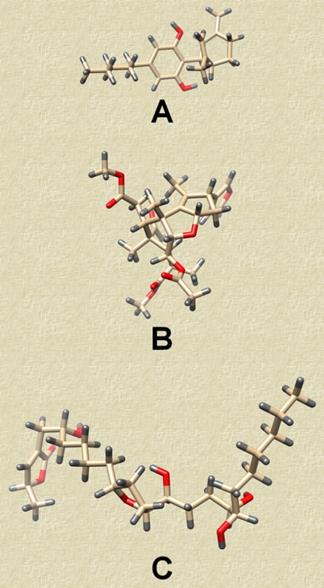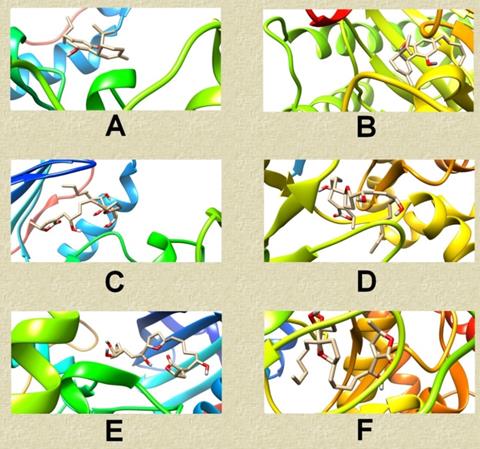J Biomed 2018; 3:60-63. doi:10.7150/jbm.25815 This volume Cite
Research Paper
Targeting breast cancer cell signaling molecules PI3K and Akt by phytochemicals Cannabidiol, Nimbin and Acetogenin: An in silico approach
Department of Biotechnology, Maharishi Markandeshwar University, Mullana, Ambala, India
Received 2018-2-28; Accepted 2018-6-9; Published 2018-7-1
Abstract

The phosphatidylinositol 3-kinase (PI3K)/serine-theronine protein kinase Akt is a vital signaling cascade involved in cell survival, progression and thus causes various types of cancers. Various kinase inhibitors targeting PI3K/Akt have been extensively studied but promising results could not be obtained because of toxicity and resistance issues. The aim of present study was to analyze the interaction of plant derived natural moieties such as nimbin, cannabidiol and acetogenin to PI3K and Akt signaling molecules. Results showed that nimbin, cannabidiol and acetogenin significantly binds to both signaling molecules. They revealed almost equivalent potency of binding to PI3K at their respective active site but nimbin exhibited lower free energy of binding with Akt. A combinational drug therapy comprises of these natural metabolites that can target these specific protein kinases efficiently can prove as a boon for breast and other cancers treatment.
Keywords: Akt, Acetogenin, Cannabidiol, PI3K, Nimbin
Introduction
Breast cancer is one of the most common malignancies among women worldwide. It is characterized by distinct pathological and molecular subtypes. Inspite of major development in advance diagnostic and treatment measures, morbidity and mortality rates are still higher. Phenomenon of invasion and metastasis leads to tumor progression. Several signaling pathways including phosphatidylinositol 3-kinase (PI3K)/Akt are found to be highly involved in complicating the disease (1).
PI3K belongs to a family of lipid kinases whose primary function is the phosphorylation of 3-hydroxy group of phosphoinositides. Binding of a growth factor to its cognate receptor tyrosine kinase (RTK), activates PI3K. Insulin like growth factor 1 receptor (IGF-1R) are amongst the predominant receptors involved in activating PI3K. On activation, PI3K heterodimer interacts with its intracellular portion via p85, a regulatory subunit of PI3K (2). This binding facilitates the removal of inhibitory effect of p85 on p110 which in turn, completely activates PI3K. Activated PI3K plays a vital role in cellular proliferation, survival, metabolism and differentiation. Monoclonal antibodies, tyrosine kinase inhibitors and PI3K inhibitors have been extensively studied to target PI3K but promising results yet to be explored (3). Large number of mutations happening in PI3K could be a reason because of which several drugs have lost their therapeutic potential in targeting this signaling molecule. Toxicity and resistance were the other issues which further limited the use of conventional options (4).
Akt, a pro-survival signaling pathway have been reported to be deregulated in breast cancer patients. Akt pathway plays a predominant role in cell proliferation, survival, progression, invasion, metastasis and anti-apoptosis and also contributes to events of tumorigenesis. Upon localization at plasma membrane, Akt gets phosphorylated and thus induces protein synthesis and cell growth via the activation of mammalian target of rapamycin (mTOR). To combat the issue of breast cancer, Akt was observed to be an attractive target (5, 6).
Various medicinal plants are widely known to cure inflammatory conditions, diabetes, parasitic infections, neuralgia and cancer (7). Their active components can exhibit high therapeutic potency to target various signaling pathways involved in complicating the breast cancer. The following sections of the article will briefly discuss the role of these 3 natural moieties named as nimbin, cannabidiol and acetogenin in overcoming various complications of breast cancer.
Nimbin is an active constituent of Azadirachta indica leaves extract. In a recent study conducted on both MCF-7 and MDA MB-231 breast cancer cells revealed that crude extract decreases the expression of various signaling molecules such as RAS, RAF, p-Erk, p-Akt and Cyclin D1 (8, 9). Thus active constituents of neem leaf extract can be used as a potent inhibitor of breast cancer progression by virtue of their ability to target various signaling molecules involved in complicating the disease.
A well-known medicinal plant, Cannabis indica is known to contain a non-psychoactive component, cannabidiol (CBD). A study conducted by Ligresti et al revealed that CBD significantly inhibits the growth of MCF-7 and MDA-MB231 breast tumor cell lines at the IC50 value of 6 μM and also exhibits lower potency in non-cancer cells. CBD and CBD rich extract also reduces the growth of xenografts. They reduces the infiltration of lung metastasis in athymic mice injected with human MDA-MB231. Hence, it can be clearly said that CBD can be used as a potent inhibitor of signaling pathways to combat the issue of breast cancer (10 - 12).
Annona muricata popularly known as Graviola or Soursop is widely known for its medicinal benefits. Annonaceous acetogenins is considered as to be the major bioactive constituent of it. A study conducted by Najmuddin et al observed the cytotoxic effects induced by Annona muricata crude extract against various breast cancer cell lines. A significant decreased level of nitric oxide (NO) and malondialdehydes was observed in tumor cells with a significant increase in white blood cells. Reduction in tumor size and weight, induction of apoptosis and anti-metastatic features were also observed in 4TI cells on treatment with crude extract (13). However the potency of acetogenins to target various signaling pathways is yet to be explored.
The present research article is an attempt to determine the efficacy of cannabidiol, nimbin and acetogenin to bind to PI3K and Akt by molecular docking studies.
Materials and Methods
To determine the efficacy of ligands to which bind to receptor molecule, their crystallographic data were taken in Cartesian coordinate. From the RCSB protein database, 3D structure of PI3K and Akt was obtained with PDB id 1E7V and 4EKL respectively. 3D structure of ligands chosen for this study namely cannabidiol, nimbin and acetogenin were prepared by using Frog server from canonical smile obtained from Pubchem. Ligands have been docked with PI3K and Akt using autodock tools of Autodock 4.2.6 package. Based upon Lamarckian Genetic Algorithm (LGA) with maximum 250000 energy, binding affinity of ligands to receptor molecule was evaluated in order to assess their potency to be used as PI3K and Akt inhibitor [Table 1, Figure 1] (14, 15).
3D structure of natural metabolites; (A): Cannabidiol, (B): Nimbin and (C) Acetogenin

Pubchem Id and Canonical Smiles of Cannabidiol, Nimbin and Acetogenin
| Name | Pubchem ID | Canonical Smiles |
|---|---|---|
| Cannabidiol | 644019 | CCCCCC1=CC(=C(C(=C1)O)C2C=C(CCC2C(=C)C)C)O |
| Nimbin | 108058 | CC1=C2C(CC1C3=COC=C3)OC4C2(C(C5(C(C4OC(=O)C)C(C=CC5=O)(C)C(=O)OC)C)CC(=O)OC)C |
| Acetogenin | 393472 | CCCCCCC(C(CCC(C1CCC(O1)CCCCC(CC2=CC(OC2=O)C)O)O)O)O |
Active binding sites of PI3K and Akt for cannabidiol, nimbin and acetogenin
| Cannabidiol | Nimbin | Acetogenin | |
|---|---|---|---|
| Akt | GLU191, HIS194, ASP274 | LYS179, LEU181, GLU191, HIS194, THR195, GLU234, GLU278, ASP292 | LYS179, GLU191, HIS194,THR195, ASP274, ASN279, THR291, ASP292 |
| PI3K | MET804, SER806, PRO810, ILE831, TYR867, ILE879, GLU880, VAL882, THR887, ASP950, MET953, PHE961, ILE963 | GLU880, ILE881, VAL882, THR887, ASP950 | SER806, LYS808, TYR867, GLU880, ILE881, VAL882, ASP950, ASN951, ILE963, ASP964 |
Representing binding affinity of Cannabiidiol, nimbin and acetogenin with PI3K and Akt separately
| Cannabidiol (kcal/mol) | Nimbin (kcal/mol) | Acetogenin (Kcal/mol) | |
|---|---|---|---|
| Akt | -6.9 | -8.2 | -7.4 |
| PI3K | -7.2 | -6.8 | -7.2 |
Results and Discussions
Cannabidiol, acetogenin and nimbin molecules have been docked to PI3K and Akt signaling molecules using Autodock 4.2.6 package. All the 3 ligands were separately docked to both receptors. Akt macromolecule forms binding site for cannabidiol which is a potential drug candidate for cancer, consists of GLU191, HIS194, ASP274 residues which displays an affinity of -6.9 Kcal/mol for cannabidiol [Fig 2:(A)]. Whereas, the another receptor PI3K possess an active site consists of residues MET804, SER806, PRO810, ILE831, TYR867, ILE879, GLU880, VAL882, THR887, ASP950, MET953, PHE961, ILE963 which displays an affinity of -7.2 kcal/mol for cannabidiol [Fig 2:(B)]. Acetogenin binds to Akt at active site comprises of LYS179, GLU191, HIS194,THR195, ASP274, ASN279, THR291, ASP292 with -7.4 Kcal/mol energy [Fig 2:(C)] and at active site comprises of SER806, LYS808, TYR867, GLU880, ILE881, VAL882, ASP950, ASN951, ILE963, ASP964 residues it significantly binds to PI3K with -7.2 Kcal/mol [Fig 2:(D)]. Third ligand named as nimbin binds to Akt with energy -8.2 kcal/mol at active site comprises of LYS179, LEU181, GLU191, HIS194, THR195, GLU234, GLU278, ASP292 [Fig 2:(E)] and to PI3K it binds with little lesser affinity at site GLU880, ILE881, VAL882, THR887, ASP950 with -6.8 Kcal/mol [Fig 2:(F)]. Although all the three ligands showed significant potency to bind to both the signaling molecules but nimbin exhibited highest potential to bind to Akt and all the three ligands showed almost equivalent potency to bind to PI3K at their active sites [Table 2].
Docked images of; (A): Akt-Cannabidiol, (B): PI3K-Cannabidiol, (C): Akt-Acetogenin, (D): PI3K-Acetogenin, (E): Akt-Nimbin, (F): PI3K-Nimbin

Conclusion
Conventional therapies significantly affects the patient's quality of life. Hence there is an urgent need to introduce herbal medicines which can efficiently overcome the complications of breast cancer without inducing any side effects. Molecular docking has become a popular approach now a days to check the efficiency of various drugs before conducting its clinical trials. Cannabidiol, nimbin and acetogenin an active constituent of Cannabis indica, Azadirachta indica and Annona muricata respectively exhibits very high binding affinity to PI3K and Akt signaling molecules. More in vitro studies needs to be carried out to reveal their potency to target PI3K and Akt signaling pathway to combat the complications of breast cancer.
Acknowledgements
We acknowledge the help provided by Maharishi Markendeshwar University, Mullana, Ambala, Haryana, India.
Competing Interests
The authors have declared that no competing interest exists.
References
1. Baselga J. Targeting the phosphoinositide-3 (PI3) kinase pathway in breast cancer. Oncologist. 2011;1:12-9
2. Chai S, Shi W. Pathway in the Breast Cancer Therapy. JSM Clinical Oncology and Research. JSM Clin Oncol Res. 2016;4(1):1048
3. Garcia-Echeverria C, Sellers WR. Drug discovery approaches targeting the PI3K/AKT pathway in cancer. Oncogene. 2008(41):5511-5526
4. Cantley LC. The phosphoinositide 3-kinase pathway. Science. 2002;296:1655-1657
5. West K.A, Dennis P.A. Starting with the ABCs: Akt in Breast Cancer. Molecular cancer therapeutics. 2011;10:1535-7163
6. Clark AR, Toker A. Signalling specificity in the Akt pathway in breast cancer. Biochem Soc Trans. 2014;42(5):1349-55
7. Riyazzudin M, Sharma M, Kaur G, Chaudhry N. A review on Therapeutic Potential of plant derived natural compounds. Bio-Chemiae Acta. 2016;1(1):30-4
8. Elumalai P, Gunadharini D. N, Senthilkumar K, et al. Ethanolic neem (Azadirachta indica A. Juss) leaf extract induces apoptosis and inhibits the IGF signaling pathway in breast cancer cell lines. Biomedicine and Preventive Nutrition. 2012;2(1):59-68
9. Arora B, Chaudhry N, Mittal R. Effects of varying environment on production of biologically active compounds in neem. Bio-Chemiae Acta. 2016;1(1):106-13
10. Massi P, Solinas M, Cinquina V, Parolaro D. Cannabidiol as potential anticancer drug. Br J Clin Pharmacol. 2013;75(2):303-12
11. Ligresti A, Moriello AS, Starowicz K, Matias I, Pisanti S, De Petrocellis L, Laezza C, Portella G, Bifulco M, Di Marzo V. Antitumor activity of plant cannabinoids with emphasis on the effect of cannabidiol on human breast carcinoma. J Pharmacol Exp Ther. 2006;318:1375-87
12. Dai Y, Harinantenaina L, Brodie P.J, Callmander M.W, Randrianaivo R, Rakotonandrasana S, Rakotobe E, Rasamison V.E, Shen Y, TenDyke K, Suh E.M, Kingston D.G. Antiproliferative Acetogenins from a Uvaria sp. from the Madagascar Dry Forest. J Nat Prod. 2012;75(3):479-483
13. Najmuddin S, Romli M.F, Hamid M, Alitheen N.B, Rahman N. Anti-cancer effect of Annona Muricata Linn Leaves Crude Extract (AMCE) on breast cancer cell line. BMC Complementary and Alternative Medicine. 2016;16:311
14. Ferreira LG, dos Santos RN, Oliva G, Andricopulo AD. Molecular docking and structure- based drug design strategies. Molecules. 2015;20(7):13384-421
15. Morris GM, Huey R, Lindstrom W, Sanner MF, Belew RK, Goodsell DS, Olson AJ. AutoDock4 and AutoDockTools4: Automated docking with selective receptor flexibility. Journal of computational chemistry. 2009;30(16):2785-91
Author contact
![]() Corresponding author: Department of Biotechnology, Maharishi Markendeshwar University, Mullana, Haryana-133203, India. Tel: +91 9876722596; E-mail: tapanmucom
Corresponding author: Department of Biotechnology, Maharishi Markendeshwar University, Mullana, Haryana-133203, India. Tel: +91 9876722596; E-mail: tapanmucom